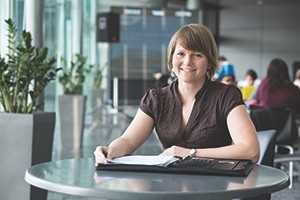What's the solar potential of your rooftop?

Have you ever wondered how much power you could generate from the sunlight hitting your roof? If you live in Auckland, wonder no more.
Geographical 3D computer modelling by Dr Kiti Suomalainen, from the University of Auckland Business School, provides the solar rooftop potential of half a million Auckland homes down to one square metre. Thought to be the first of its kind in New Zealand, the model lists the solar potential of Auckland suburbs via a scale of one (<1100 kWh/m2) to five (1400–1500 kWh/m2) by the best 36 m2 of each building.
Dr Suomalainen built the model by working with point elevation data provided by Auckland Council. This data was collected by planes that criss-crossed the city, emitting light pulses and timing how long it took for the reflected light to return to the plane, which gave the distance from the reflected surface to the plane. She converted this to a 3D model and overlaid it with building footprints, then excluded heavily industrial and sparsely populated areas.
She then used the trajectory of the sun through the sky across the year, the compass orientation and roof slopes calculated from the 3D model to calculate the annual solar radiation on each point on the roof, factoring in the effect of trees, neighbouring buildings and topography. Finally, she devised a five-point scale to indicate the solar potential by individual building and by neighbourhood.
So what are the results? It turns out the top 20 places for solar are mostly cheap-to-mid-range neighbourhoods, with the top three located in the Southeast Auckland suburbs of Kilkenny (3.92), Maungamaungaroa (3.90) and Millhouse (3.89).
“A lot of the leafy suburbs aren’t that good for solar, because they are leafy — the trees shade the rooftops,” said Dr Suomalainen.
“Also, a lot of the older, more expensive suburbs are on hilly terrain, which can also reduce the sunlight that reaches the roofs.”
As well as helping target rooftop installation of solar panels where they would generate the most power, the model could also help avert the feared ‘death spiral’ that happens when a new, ‘disruptive’ technology threatens to cannibalise the market for an existing technology.
“You don’t want to build in solar in a way that will offset existing generation technologies that are already renewable,” said engineering lecturer Dr Tony Downward, noting that 75–80% of the country’s electricity is already renewable.
“This tool could help selectively promote the installation of solar in certain areas in order to reduce our reliance on non-renewable thermal plants,” he continued.
Dr Suomalainen, along with Dr Downward, will give a talk about the model and its potential uses at the Business School on 30 April. She also intends to eventually make the rooftop results public and searchable by address.
Solar cell achieves world record for efficiency
University of Queensland researchers have set a world record for solar cell efficiency with...
Boral secures grant for cement kiln carbon reduction
The project will reduce process emissions from cement clinker manufacturing by up to...
Vast secures grant to progress SA Solar Fuels project
HyFuel Solar Refinery, a subsidiary of Vast, has been awarded $700,000 through the ASLET...










